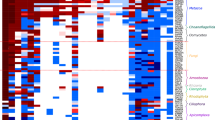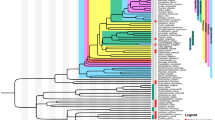Abstract
The distribution of protein domains was analyzed in superkingdoms Archaea, Bacteria, and Eukaryota. About a half of eukaryotic domains have prokaryotic origin. Many domains related to information processing in the nucleocytoplasm were inherited from archaea. Sets of domains associated with metabolism and regulatory and signaling systems were inherited from bacteria. Many signaling and regulatory domains common for bacteria and eukaryotes were responsible for the cellular interaction of bacteria with other components of the microbial community but were involved in coordination of the activity of eukaryotic organelles and cells in multicellular organisms. Many eukaryotic domains of bacterial origin could not originate from ancestral mitochondria and plastids but rather were adopted from other bacteria. An archaeon with the induced incorporation of alien genetic material could be the ancestor of the eukaryotic nucleocytoplasm.
Similar content being viewed by others
REFERENCES
Brocks, J.J., Logan, G.A., Buick, R., and Summons, R.E., Archean Molecular Fossils and the Early Rise of Eukaryotes, Science, 1999, vol. 285, no.5430, pp. 1025–1027.
Canback, B., Andersson, S.G.E., and Kurland, C.G., The Global Phylogeny of Glycolytic Enzymes, Proc. Natl. Acad. Sci. USA, 2002, vol. 99, no.9, pp. 6097–6102.
Dolan, M.F., Melnitsky, H., Margulis, L., and Kolnicki, R., Motility Proteins and the Origin of the Nucleus, Anat. Rec., 2002, no. 268, pp. 290–301.
Dyall, S.D., Brown, M.T., and Johnson, P.J., Ancient Invasions: From Endosymbionts to Organelles, Science, 2004, vol. 304, no.5668, pp. 253–257.
Emelyanov, V.V., Mitochondrial Connection to the Origin of the Eukaryotic Cell, Eur. J. Biochem., 2003, vol. 270, no.8, pp. 1599–1618.
Esser, C., Ahmadinejad, N., Wiegand, C., et al., A Genome Phylogeny for Mitochondria among Alpha-Proteobacteria and a Predominantly Eubacterial Ancestry of Yeast Nuclear Genes, Mol. Biol. Evol., 2004, vol. 21, no.9, pp. 1643–1660.
Feng, D.F., Cho, G., and Doolittle, R.F., Determining Divergence Times with a Protein Clock: Update and Reevaluation, Proc. Natl. Acad. Sci. USA, 1997, vol. 94, no.24, pp. 13028–13033.
Gabaldon, T. and Huynen, M.A., Reconstruction of the Proto-Mitochondrial Metabolism, Science, 2003, vol. 301, no.5633, p. 609.
Gupta, R.S., Protein Phylogenies and Signature Sequences: A Reappraisal of Evolutionary Relationships among Archaebacteria, Eubacteria, and Eukaryotes, Microbiol Mol. Biol. Rev., 1998, vol. 62, no.4, pp. 1435–1491.
Gusev, M.V. and Mineeva, L.A., Mikrobiologiya (Microbiology), Moscow: Mosk. Gos. Univ., 1992, 3rd ed.
Hartman, H. and Fedorov, A., The Origin of the Eukaryotic Cell: a Genomic Investigation, Proc. Nat. Acad. Sci. USA, 2002, vol. 99, no.3, pp. 1420–1425.
Helenius, A. and Aebi, M., Intracellular Functions of N-Linked Glycans, Science, 2001, vol. 291, no.5512, pp. 2364–2369.
Jenkins, C., Samudrala, R., Anderson, I., et al., Genes for the Cytoskeletal Protein Tubulin in the Bacterial Genus Prosthecobacter, Proc. Natl. Acad. Sci. USA, 2002, vol. 99, no.26, pp. 17049–17054.
Kurland, C.G. and Andersson, S.G.E., Origin and Evolution of the Mitochondrial Proteome, Microbiol. Mol. Biol. Rev., 2000, vol. 64, no.4, pp. 786–820.
Margulis, L., Rol’ simbioza v evolyutsii kletki (The Role of Symbiosis in Evolution of the Cell), Moscow: Mir, 1983.
Margulis, L., Dolan, M.F., and Guerrero, R., The Chimeric Eukaryote: Origin of the Nucleus from the Karyomastigont in Amitochondriate Protists, Proc. Natl. Acad. Sci. USA, 2000, vol. 97, no.13, pp. 6954–6959.
Markov, A.V., On the Origin of the Eukaryotic Cell, Paleontol. Zh., 2005, vol. 39, no.2.
Martin, W., Gene Transfer from Organelles To the Nucleus: Frequent and in Big Chunks, Proc. Natl. Acad. Sci. USA, 2003, vol. 100, no.15, pp. 8612–8614.
Martin, W. and Muller, M., The Hydrogen Hypothesis for the First Eukaryote, Nature, 1998, no. 392, pp. 37–41.
Martin, W. and Russell, M.J., On the Origins of Cells: A Hypothesis for the Evolutionary Transitions from Abiotic Geochemistry to Chemoautotrophic Prokaryotes, and from Prokaryotes to Nucleated Cells, Phil. Trans. R. Soc. Lond. B Biol. Sci., 2003, vol. 358, no.1429, pp. 59–85.
Mayer, F., Cytoskeletons in Prokaryotes, Cell. Biol. Int., 2003, vol. 27, no.5, pp. 429–438.
Ng, W.V., Kennedy, S.P., Mahairas, G.G., et al., Genome Sequence of Halobacterium Species NRC-1, Proc. Natl. Acad. Sci. USA, 2000, vol. 97, no.22, pp. 12176–12181.
Noon, K.R., Guymon, R., Crain, P.F., et al., Influence of Temperature on tRNA Modification in Archaea: Methanococcoides burtonii (Optimum Growth Temperature [T opt], 23 Degrees C) and Stetteria hydrogenophila (T opt, 95 Degrees C), J. Bacteriol., 2003, vol. 185, no.18, pp. 5483–5490.
Slesarev, A.I., Belova, G.I., Kozyavkin, S.A., and Lake, J.A., Evidence for an Early Prokaryotic Origin of Histones H2A and H4 prior To the Emergence of Eukaryotes, Nucleic Acid Res., 1998, vol. 26, no.2, pp. 427–430.
Theissen, U., Hoffmeister, M., Grieshaber, M., and Martin, W., Single Eubacterial Origin of Eukaryotic Sulfide: Quinone Oxidoreductase, a Mitochondrial Enzyme Conserved from the Early Evolution of Eukaryotes during Anoxic and Sulfidic Times, Mol. Biol. Evol., 2003, vol. 20, no.9, pp. 1564–1574.
Van den Ent, F., Amos, L.A., and Lowe, J., Prokaryotic Origin of the Actin Cytoskeleton, Nature, 2001, vol. 413, no.6851, pp. 39–44.
Vellai, T. and Vida, G., The Origin of Eukaryotes: the Difference between Prokaryotic and Eukaryotic Cells, Proc. R. Soc. Lond. B Biol. Sci., 1999, vol. 266, no.1428, pp 1571–1577.
Walden, W.E., From Bacteria to Mitochondria: Aconitase Yields Surprises, Proc. Natl. Acad. Sci. USA, 2002, vol. 99, no.7, pp. 4138–4140.
Zavarzin, G.A., Development of Microbial Communities in the Earth’s History, in Problemy doantropogennoi evolyutsii biosfery (Problems of Pre-anthropogenic Evolution of the Biosphere), Moscow: Nauka, 1993, pp. 212–222.
Author information
Authors and Affiliations
Additional information
__________
Translated from Izvestiya Akademii Nauk, Seriya Biologicheskaya, No. 4, 2005, pp. 389–400.
Original Russian Text Copyright © 2005 by Markov, Kulikov.
Rights and permissions
About this article
Cite this article
Markov, A.V., Kulikov, A.M. Homologous Protein Domains in Superkingdoms Archaea, Bacteria, and Eukaryota and the Problem of the Origin of Eukaryotes. Biol Bull Russ Acad Sci 32, 321–330 (2005). https://doi.org/10.1007/s10525-005-0108-0
Received:
Issue Date:
DOI: https://doi.org/10.1007/s10525-005-0108-0




